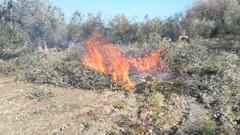URL: https://www.desy.de/news/news_search/index_eng.html
Breadcrumb Navigation
DESY News: Toxic soil
News
News from the DESY research centre
Toxic soil
When exposed to fire, chromium compounds in the soil can transform from harmless chemical forms into potentially toxic time bombs, a research team from the University of Bari “Aldo Moro” and the Polytechnic of Bari in Italy and DESY has discovered with the help of DESY's X-ray source PETRA III. The result is published in the scientific journal Journal of Hazardous Materials.
Chromium is found almost everywhere and, compounds with trivalent chromium (III) are usually innocuous, even at quite high concentrations in the environment. However, some chromium compounds are highly toxic to humans and animals and can cause cancer – for example with hexavalent chromium (VI), in which each chromium atom has donated six electrons to its partners. Students of chemistry know both of them well: they are often used for spectroscopy experiments because the differences between the spectra can be seen very clearly.Unlike its harmless brother, chromium VI is water-soluble and mobile, so it can be more easily absorbed by plants and thus enter the food chain. The change from harmless to dangerous chromium compounds may happen when exposed to heat, the researchers have found - the hotter, the more dangerous chromium. But even small agricultural wildfires or intentional fires used as common agronomic practices – for example the burning of stubble or pruning residues – can lead to a formation of chromium VI. If things go badly, the toxic version could enter the food chain when is it absorbed by plants – for example wheat – which are then processed for humans.
This is especially a problem in Italy, where there are active tanneries for the leather industry whose chromium-containing waste was used as a basis for compost or fertilisers. Under normal circumstances, this often does not pose a threat to nature. However, if these organic amendments are present in the soil when stubble fields are burned or during a wildfire, the transformation to chromium VI is likely to occur.
For the analysis, Ignazio Allegretta from the University of Bari brought soil samples from Italy. Fires at 300, 400 and 500 degrees Celsius were simulated on the samples, which were then examined in detail using conventional chemical methods and then in part in PETRA III's P06 beamline. “We have conducted our study by considering conditions that might occur in an agricultural soil, while most of other studies refer to more extreme conditions that can be found during forest wildfires“, says principal investigator Roberto Terzano from the University of Bari’s Department of Soil, Plant and Food Sciences. “This could have more relevant implications for the safety of the foodchain.“
Thanks to the high spatial resolution at PETRA III, fluorescence analysis and microscopic spectroscopy can be used to identify the composition of the elements with an accuracy of one micrometre. “We can see much smaller particles and smaller concentrations than is possible in conventional chemical investigations,” explains DESY scientist Gerald Falkenberg, head of P06 and a co-author of the study. “For example, we were also able to see where exactly chromium VI formed and what elements were present nearby.”
The team was able to show from the soil samples that, though chromium VI had formed only very locally, using organic materials containing high concentrations of potentially toxic elements in agriculture to improve soil organic matter content could become a source of pollution and toxicity if fires impact those soils. “The extent of the relevance of these phenomena and if they can really constitute a risk need to be further investigated at field scale, but our first evidence shows that the potential risks should not be underestimated, and nowadays fires should be considered in risk assessment studies,” Terzano explains.
Reference:
Evidence of hexavalent chromium formation and changes of Cr speciation after laboratory-simulated fires of composted tannery sludges long-term amended agricultural soils; Ida Rascio, Ignazio Allegretta, Concetta Eliana Gattullo, Carlo Porfido, Gian Paolo Suranna, Roberto Grisorio, Kathryn M. Spiers, Gerald Falkenberg, Roberto Terzano; „Journal of Hazardous Materials“, 2022; DOI: 10.1016/j.jhazmat.2022.129117




